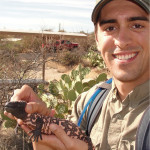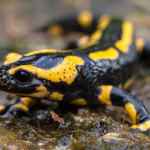
Female Kihansi Spray Toad with her young toadlet. Courtesy of the Wildlife Conservation Society. Photo: Julie Larsen Maher
Recently more than 2,000 Kihansi spray toads (Nectophrynoides asperginis), an amphibian species that was declared extinct in the wild in 2009, made the long journey from Toledo, Ohio, and Bronx, New York, to Africa. They were returning to their native habitat in the Kihansi Gorge in Tanzania.
These tiny toads are unique in that they live in a micro-habitat—it was created by the spray of nearby waterfalls in the Kihansi Gorge and covers only five acres. This is the smallest range of any known vertebrate species.
In 1990, a hydroelectric dam was constructed that reduced the spray of the falls by 90 percent and so lessened the mist zone that the toads needed for survival. The toad population was also devastated by the chytrid fungus, which has devastated amphibian populations worldwide.
As the toad populations were declining, the Wildlife Conservation Society’s (WCS) Bronx Zoo, and later the Toledo Zoo, in agreement with the Tanzanian government (and with the help of numerous organizations—see below), removed 500 toads from the gorge and brought them to the US. Special microhabitats were created for the toads and both zoos were able to breed them successfully.
Now over 2,400 toads have been successfully released in the wild. Before being released, scientists from the University of Dar es Salaam and Sokoine University of Agriculture certified the area as being free from chytrid fungus.
This is the first time that an amphibian that was extinct in the wild has been returned to its native habitat.
Organizations involved in reintroducing the kihansi toad to the wild include the Wildlife Conservation Society’s Bronx Zoo, the Toledo Zoo, Tanzanian government, World Bank, University of Dar Es Salaam, International Union for Conservation of Nature (IUCN), Wildlife Division and Tanzania Wildlife Research Institute, Sokoine University of Agriculture, Tanzania Electric Supply Company, and local Tanzanian villagers all took part.
Sources:
Scientific American
All Africa.com
Hudson Valley Press




